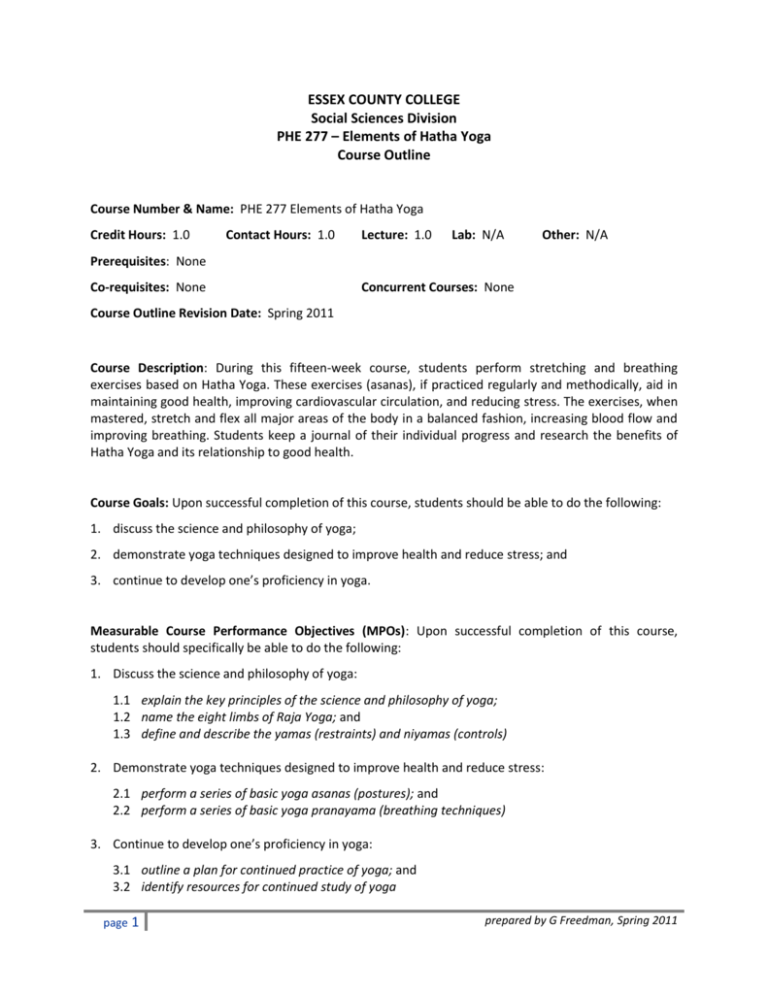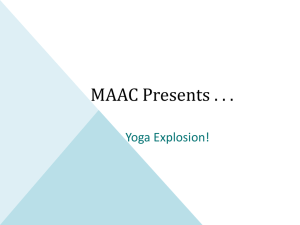phe.277.outline.f2010 - Student Learning Outcomes (SLO)
advertisement

ESSEX COUNTY COLLEGE Social Sciences Division PHE 277 – Elements of Hatha Yoga Course Outline Course Number & Name: PHE 277 Elements of Hatha Yoga Credit Hours: 1.0 Contact Hours: 1.0 Lecture: 1.0 Lab: N/A Other: N/A Prerequisites: None Co-requisites: None Concurrent Courses: None Course Outline Revision Date: Spring 2011 Course Description: During this fifteen-week course, students perform stretching and breathing exercises based on Hatha Yoga. These exercises (asanas), if practiced regularly and methodically, aid in maintaining good health, improving cardiovascular circulation, and reducing stress. The exercises, when mastered, stretch and flex all major areas of the body in a balanced fashion, increasing blood flow and improving breathing. Students keep a journal of their individual progress and research the benefits of Hatha Yoga and its relationship to good health. Course Goals: Upon successful completion of this course, students should be able to do the following: 1. discuss the science and philosophy of yoga; 2. demonstrate yoga techniques designed to improve health and reduce stress; and 3. continue to develop one’s proficiency in yoga. Measurable Course Performance Objectives (MPOs): Upon successful completion of this course, students should specifically be able to do the following: 1. Discuss the science and philosophy of yoga: 1.1 explain the key principles of the science and philosophy of yoga; 1.2 name the eight limbs of Raja Yoga; and 1.3 define and describe the yamas (restraints) and niyamas (controls) 2. Demonstrate yoga techniques designed to improve health and reduce stress: 2.1 perform a series of basic yoga asanas (postures); and 2.2 perform a series of basic yoga pranayama (breathing techniques) 3. Continue to develop one’s proficiency in yoga: 3.1 outline a plan for continued practice of yoga; and 3.2 identify resources for continued study of yoga page 1 prepared by G Freedman, Spring 2011 Methods of Instruction: Instruction will consist of a combination of lecture, demonstration, and practice of asanas (postures), pranayama (breathing techniques), and meditation. Outcomes Assessment: Assignments and journal entries are blueprinted to course objectives. Checklist rubrics are used to evaluate class participation and completion of asanas (postures) and pranayama (breathing techniques) for the presence and mastery of course objectives. Data is collected and analyzed to determine the level of student performance on these assessment instruments in regards to meeting course objectives. The results of this data analysis are used to guide necessary pedagogical and/or curricular revisions. Course Requirements: All students are required to: 1. Attend all classes on time and actively participate in class discussions and activities. 2. Read the textbook and study supplementary resources. 3. Keep a journal of progress and understanding. Methods of Evaluation: Final course grades will be computed as follows: Grading Components % of final course grade Attendance & Class Participation Students need to attend and participate in class to benefit from the guidance of the instructor, to observe necessary demonstrations, and to practice yoga. Evaluations of students’ participation will provide evidence of mastery of course objectives. 80% Assignments Assignments are given on a regular basis throughout the semester to reinforce student mastery of course objectives. 10% Journal The student journal will provide evidence of student mastery of course objectives and synthesis of concepts covered in the course. 10% page 2 prepared by G Freedman, Spring 2011 Academic Integrity: Dishonesty disrupts the search for truth that is inherent in the learning process and so devalues the purpose and the mission of the College. Academic dishonesty includes, but is not limited to, the following: plagiarism – the failure to acknowledge another writer’s words or ideas or to give proper credit to sources of information; cheating – knowingly obtaining or giving unauthorized information on any test/exam or any other academic assignment; interference – any interruption of the academic process that prevents others from the proper engagement in learning or teaching; and fraud – any act or instance of willful deceit or trickery. Violations of academic integrity will be dealt with by imposing appropriate sanctions. Sanctions for acts of academic dishonesty could include the resubmission of an assignment, failure of the test/exam, failure in the course, probation, suspension from the College, and even expulsion from the College. Student Code of Conduct: All students are expected to conduct themselves as responsible and considerate adults who respect the rights of others. Disruptive behavior will not be tolerated. All students are also expected to attend and be on time for all class meetings. No cell phones or similar electronic devices are permitted in class. Please refer to the Essex County College student handbook, Lifeline, for more specific information about the College’s Code of Conduct and attendance requirements. page 3 prepared by G Freedman, Spring 2011 Course Content Outline: based on the text The Royal Path: Practical Lessons on Yoga; by Swami Rama; published by Himalayan Institute Press, 1979; ISBN-13 #: 978-0893891527 Week Topics 1–2 What is Yoga? 3–4 Yama and Niyama 5–6 Asanas and their Therapeutic Value 7–8 Pranayama 9 – 10 A Few Glimpses of Concentration 11 – 12 The Mind and Its Analysis 13 – 14 What is Meditation? 15 Samadhi NOTE: Assignments and journal writing exercises related to and designed to enhance student mastery of course objectives are made throughout the semester. page 4 prepared by G Freedman, Spring 2011








